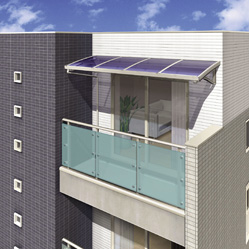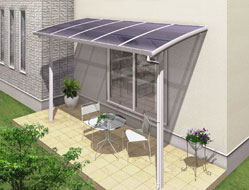STEP AHEAD IN INNOVATIVE SOLUTIONS
Content
Protective covers
Canopies
Polycarbonate


Nowadays, FURQAN Company presents contemporary canopies in which last time’s achievements are embodied. One of such achievements is polycarbonate.
Polycarbonates are a particular group of thermoplastic polymers characterized by a combination of outstanding impact strength, superior dimensional stability, high transparency, remarkable thermal resistance and nice optical and electrical properties. In addition, they have ductility and are distinguishable from other engineering thermoplastics by their freedom of design that allows engineers selecting a combination of these properties to meet specification requirements for a broad range of application needs. So, polycarbonates are becoming more common in housewares as well as in industries (chemical, electronic and other), laboratories, advertising and so on where high performance properties of any of their main features are required.
Prevalence of polycarbonate in housewares is due to its high dielectric strength and high volume resistivity. Polycarbonate maintains its properties over a wide range of temperatures and will not shrink with age. Some shrinkage occurs when it is heated to forming temperature, but postforming stability is excellent. So, polycarbonate is very apt for electrical applications.
Polycarbonate has good thermoforming characteristics. Even when formed, machined and finished according to recommended techniques and procedures for secondary operations, the final result will be a high quality product.
Main transformation techniques for polycarbonate raw materials:
• injection moulding into ready articles,
• extrusion into plate, tubes, rods and other profiles,
• extrusion into sheets (1-15 mm) and films (below 1 mm), which can be used directly or manufactured into other shapes using thermoforming or secondary fabrication techniques, such as bending, drilling, laser cutting etc.
No special tools are needed, and finished parts can be polished to a high gloss. Polycarbonate can be machined on standard metalworking or woodworking equipment and also it can be machined by standard metal working tools. Its unique properties permit it to be machined without chipping, splitting, or breaking.
Polycarbonate lenses are manufactured differently from the way that other lens materials are fabricated. An enormous amount of pressure is used to compress the raw material. However, the resulting product holds up so well under impact not because it is hard and unyielding, but rather because it is flexible and gives slightly under pressure without breaking. Polycarbonate lenses are actually constructed out of material that is identical to what is called "bulletproof glass".
Studies have been made detailing exactly what happens when an object traveling at high speed meets a polycarbonate lens versus a traditional plastic lens. Using film that is slowed down and viewed frame by frame, one investigation demonstrated that a fast-moving ball coming into contact with a plastic lens broke the lens and impacted the eye. Pieces of the lens are sprayed around, which potentially can cause injury to eyes of others. In contrast, the same object traveling at the same rate of speed impacted the polycarbonate lens and flexed the lens but did not break it. So, impact resistant polycarbonate lenses are safer for eyeglasses than traditional lens materials. In addition to this, polycarbonate withstands repeated blows without shattering and spalling.
Since polycarbonate lenses are difficult to break, they are useful wherever safety, security or impact-resistance is important - in sports goggles, children's glasses and some safety eyewear.
Also, it is necessary to note, that polycarbonate is highly transparent to visible light and has better light transmission characteristics than many kinds of plastics. Because less of the polycarbonate lens material is needed to provide the same amount of visual correction that a traditional plastic lens offers, polycarbonate lenses are thinner and lighter in weight. Moreover, they also offer ultraviolet (UV) and infra-red (IR) protection. Similar to the way that sunblock prevents the sun's rays from damaging the body, UV protection in polycarbonate shields the eyes from the same detrimental light rays. Other types of plastic lenses must be specially treated to block the same amount of UV, but polycarbonate lenses automatically offer this protection.
Polycarbonate allows that a scratch resistant coating to be applied to the front and back surfaces of lenses. And manufacturers automatically coat them, so polycarbonate lenses have built-in scratch resistance.
All these features of polycarbonate have predetermined wideness of application: sunglass/eyeglass lenses, safety glasses, automotive headlamp lenses, Compact discs, lab equipment, research animal enclosures, shatterproof windows, drinking bottles, signs, displays, poster protection, domelights and so on. Polycarbonate has also been used for astronaut helmet shields and space shuttle windshields.